Join us on an expedition to learn more about the many types of birds-of-paradise.
You may think it is only their magnificent feathers that set them apart, but there is a lot more to this group than meets the eye.
Whether you are an experienced birdwatcher or a curious nature lover, you are in the right place to learn more about different types of birds-of-paradise.
We have selected eighteen species to highlight that will transport you to a tropical forest abuzz with dramatic plumage displays and lively birdsong.
Each species within the birds-of-paradise grouping fits into the broad category, yet each is uniquely different.
Let’s learn more about these magnificent creatures that share our planet with us.

What Is A Bird-of-Paradise?
Some will say these birds are everything but ugly animals—and that’s true. There are many attractive types of birds in the world, so why are some birds specifically classified within the charming group known as ‘birds-of-paradise?’
Birds-of-paradise fall into the broad family Paradisaeidae. This large group contains 17 genera which are the larger divisions. These are broken down further into the 45 bird-of-paradise types.
Although there is significant variation between the different types of birds-of-paradise, these solitary tree dwellers are all found mostly in the forest canopy in rainforests, swamps, and moss forests.
However, habitat destruction and deforestation due to human settlement have reduced the population levels of many bird-of-paradise species to endangered status.
You would most likely see a bird-of-paradise when visiting countries like Australia, Indonesia, and New Guinea, one of the world’s largest islands.
Almost all types of birds-of-paradise exhibit sexual dimorphism – not all, but most of them. That means that the males and females look different.
Males of the species often sport long, elaborate feathers, which they use to impress potential mates.
Birds-of-paradise may differ in appearance, but they all eat fruit as the most important part of their diet. The majority of birds-of-paradise types will also eat arthropods, but they are primarily fruit eaters.
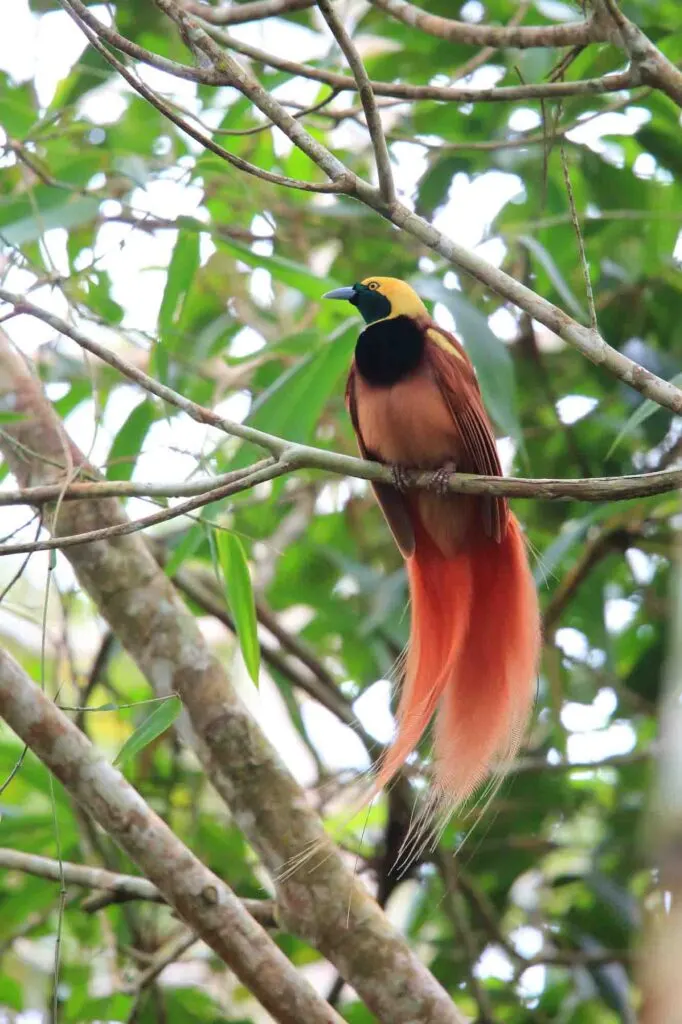
Bird-of-Paradise Types
In 2009, a comprehensive DNA study was done to find the relationships between birds classified under the broad family Paradisaeidae.
The result was not only that the species were split into five distinct clades, but scientists discovered that the family had emerged 24 million years ago, much earlier than previously thought.
The five clades were divided as follows:
Clade one
This clade split off from the rest around 10 million years ago. It contains three monogamous groups of birds-of-paradise, including the Lycocorax paradise crows, Phonygammus trumpet manucode, and five species of manucodes.
Clade two
Two types of birds-of-paradise fit into the second clade. These are the King of Saxony bird-of-paradise and parotias, of which there are six species.
Clade three
This is the biggest clade that contains several birds-of-paradise types.
Currently, genera in this group include Seleucidis twelve-wired bird-of-paradise, Drepanornis sicklebills, Ptiloris riflebirds, and Lophorina. These may change when more research has been conducted.
Clade four
Contains nine species that fall into three genera, namely, Epimachus sicklebills, Paradigallas, and Atrapias.
Clade five
There are ten species in the final clade spread across four genera. These are Paradisornis blue bird-of-paradise, Cicinnurus King bird-of-paradise, Diphyllodes birds-of-paradise, and Paradisaea birds-of-paradise.
Occasionally birds-of-paradise get mixed up and confuse members of other species for their own.
This has led to some hybridization and created a situation where the number of rare species is further declining.
18 Beautiful Types of Birds-of-Paradise
Now that we have the bird-of-paradise types behind us, let’s find out more about eighteen specific types.
1. King Bird-of-Paradise
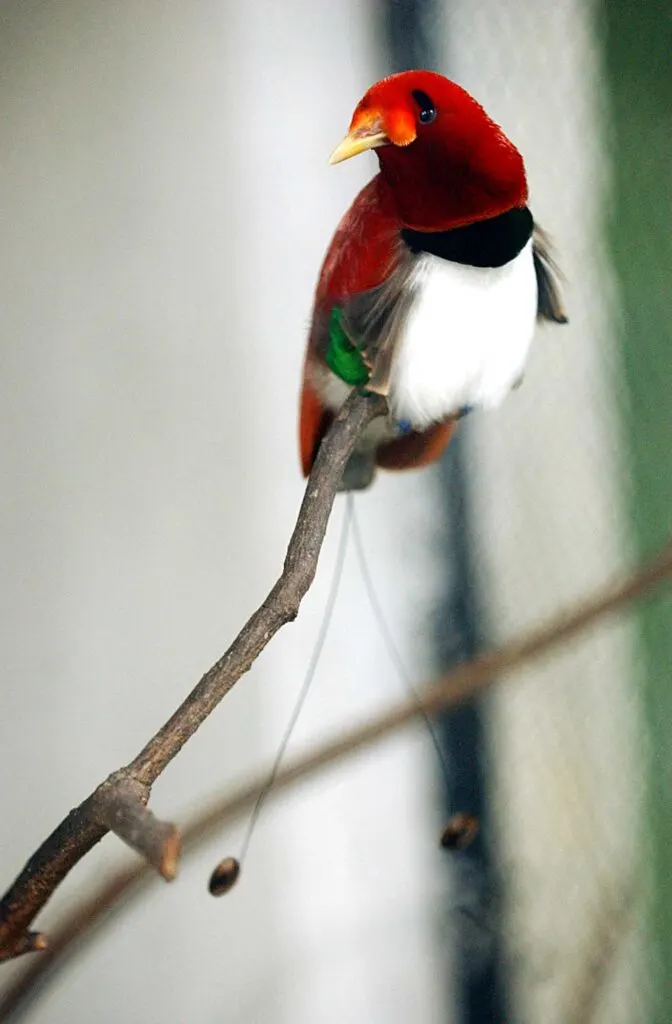
The male king bird-of-paradise is the brightest of all the types of birds-of-paradise, and it is often described as a living gem.
This tiny species is amongst the smallest in the family, and their length is between 6.3 and 7.5 inches – not including the wire-like tail feathers of male birds.
The scientific name of these colorful birds is Cicinnurus regius. This is a combination of Greek and Latin words that allude to the bird’s specialized head feathers and regius, which means king.
King birds-of-paradise are common in the lowland forests of New Guinea and some surrounding islands.
Besides their prominent bright red upper body color, males have dark green breasts, white underbelly, yellow bills, and bright blue legs.
As if that wasn’t enough bling, they also have two long wire-like tail feathers that end with green spiral disks, making them beautiful but also weird-looking birds.
In contrast, the female king bird-of-paradise is a demure brown with dark speckled patterned underparts.
They also have blue legs and yellow beaks, which are perfect for dining on a diet of fruit and arthropods.
2. Raggiana Bird-of-Paradise
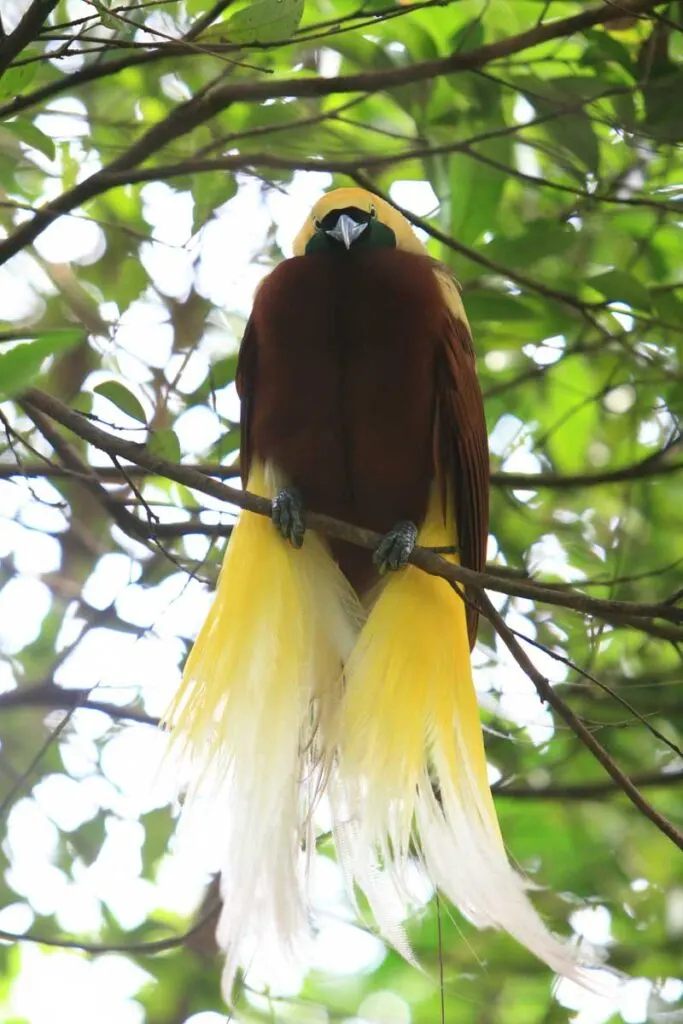
Next time you see the flag of Papua New Guinea, take a closer look at the emblem depicted.
The Raggina bird-of-paradise is the country’s national bird, and the silhouette of an adult-plumaged male bird-of-paradise appears in the top right-hand corner.
Paradisaea raggiana was named after Marquis FM Raggi, an Italian naturalist in New Guinea when it was first described.
Sexes are dimorphic, and although they are similar in size if you exclude the male’s crimson tail plumes, with two long black tail-wire feathers that extend still further, in almost all other ways, they are entirely different in appearance.
Female Raggiana birds-of-paradise are around 24 inches long and are a dull maroon color with a chocolate brown face.
Males have flashy yellow heads, and the bright color extends around to form a thin collar around the front to resemble a hooded cape.
Their chests are iridescent green, and the whole effect is juxtaposed with a mass of red and orange plumage around the flanks.
Raggiana bird-of-paradise only occurs in Papua New Guinea, where it is common in the tropical forests of the eastern areas.
In addition to being an iconic bird in the region, this type of bird-of-paradise is also vital for the ecology of the environment as it disperses important fruiting tree seeds.
Read next: 18 Colorful Types of Hummingbirds Found in the Americas
3. Trumpet Manucode
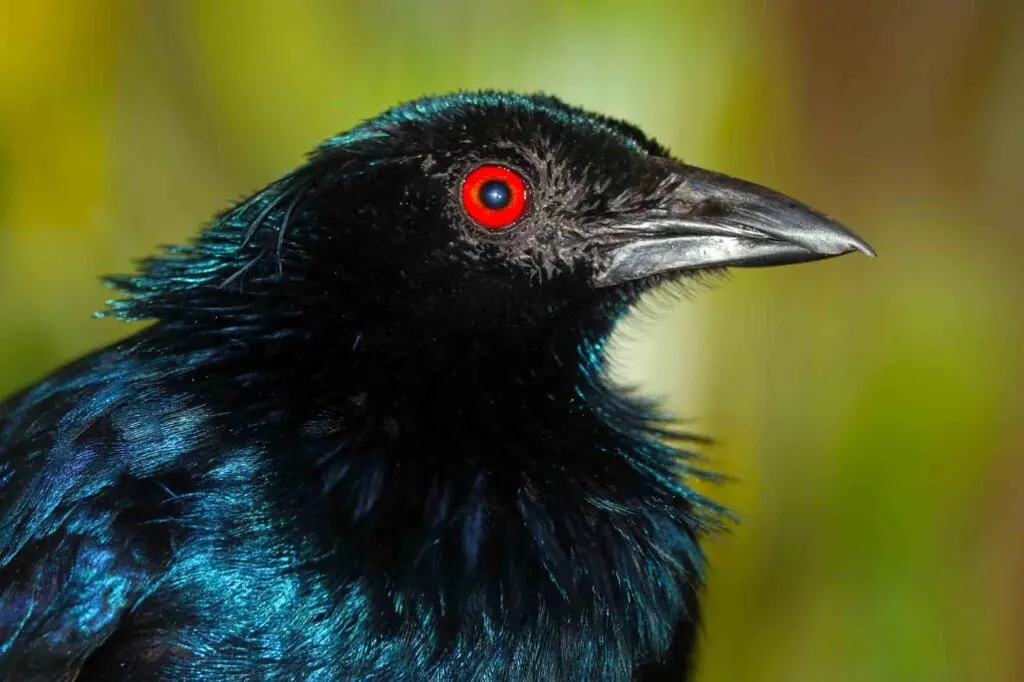
Trumpet manucodes were not named for their plumage but because of their loud calls. Their voices have been described as powerful, loud, and trumpet-like.
In appearance, trumpet manucodes are not standouts like some other types of birds-of-paradise, but they do fit squarely within their own genera.
Their scientific name is Phonygammus keraudrenii, which honors a French navy doctor from the 1800s, Dr. Pierre Keraudren.
Trumpet manucodes are not only monogamous birds, but they are also sexually monomorphic, which is unusual for birds-of-paradise.
This means that there is very little physical difference between males and females. Both have long earmuffs and a slightly longer mane of neck feathers.
Males are slightly heavier than females and weigh between 4.5 – 8.4 ounces. The average weight for adult female trumpet manucodes is between 4.5 and 6.4 ounces.
The length of mature birds also differs, with the average length of males being around 12 inches and females being an inch shorter.
These glossy blue-black birds-of-paradise are numerous and have a wide distribution area ranging from the rainforests of New Guinea to the northern Cape York area of Australia.
Like all types of birds-of-paradise, their diet consists of fruit and invertebrates.
4. Crinkle-Collared Manucode
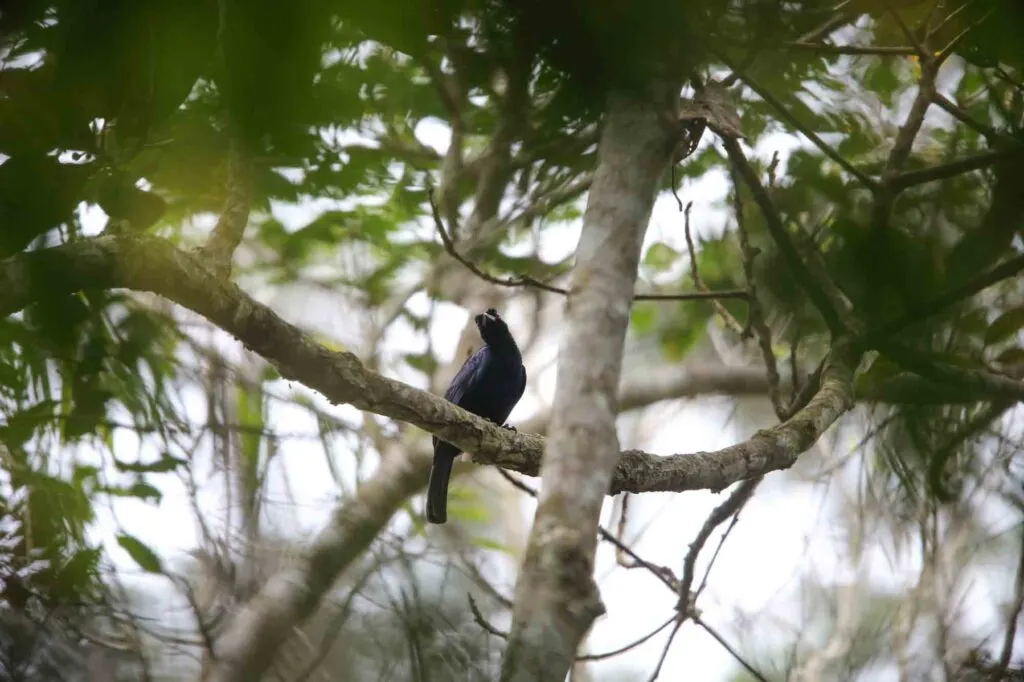
Crinkle-collared manucodes are another type of bird-of-paradise that is sexually monomorphic.
One interesting point to note, though, is that mature females are slightly larger than males and measure 13 inches, while the average length of males is 9.8 inches.
Shimmery blue-black crinkle-collared manucodes inhabit hills and lowland forests on the island of Misool in New Guinea.
Their scientific name is Manucodia chalybatus – the first part of the name refers to the genera, and the second part is a Latin word that describes the crinkly feather arrangement on the back of their neck.
Like other types of birds-of-paradise, crinkle-collared manucodes eat fruit, especially figs and insects. They have also been known to hunt small animals.
This species is very secretive, and there is not much information available about their nesting behavior.
Unlike some other birds-of-paradise types, the crinkle-collared manucodes have not hybridized. They have a life expectancy of between 5 and 8 years.
5. Lawes’s Parotia
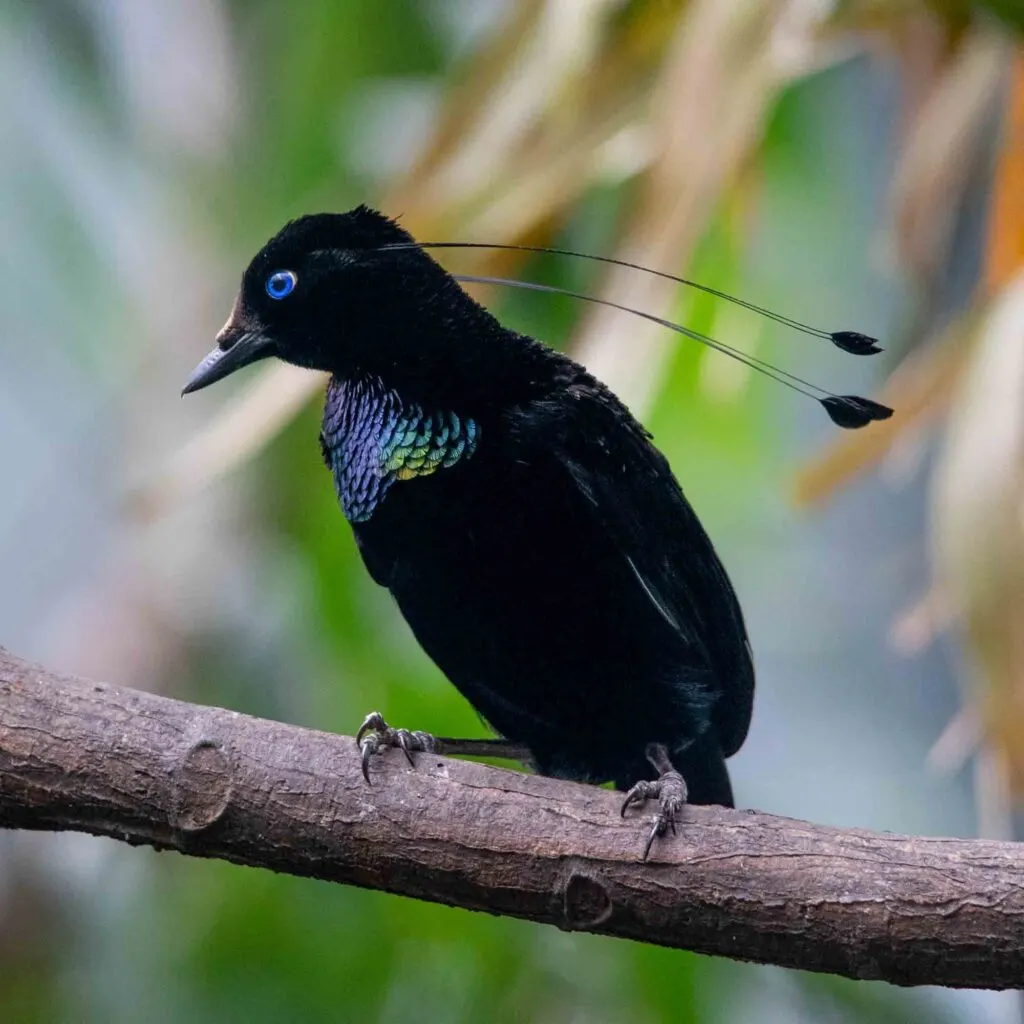
If you are in the mountain forest regions of Papua New Guinea, look out for the animated show-off courtship display of the male Lawes’s parotia.
This type of bird-of-paradise has the scientific name Patotia lawesii and is sexually dimorphic.
Males of the species sport long wire-like plumes with fluffy ends that start at the top of each eye.
That is in addition to the standout white stripe on the jet-black feathers from forehead to bill.
Their breasts are intensely colored yellow-green. Their peculiar feathering can even be lifted to give a skirt-like appearance for elaborate courtship displays.
Female Lawes’s parotia are far more demure in their appearance. They measure around 9.8 inches which is 2 inches shorter than males.
They have dark heads, plain brown upper parts, and a barred underside. Interestingly, the female’s iris can change color to different shades of blue or yellow depending on its mood.
Lawes’s parotia, like most other types of birds-of-paradise, eat fruit, seeds, and arthropods. Fortunately, the species is widespread and common in the areas it inhabits.
Did you know? Crossbreeding of hybrid birds-of-paradise can take place when visually similar individuals from different species, sharing common habitats, mistakenly identify one another as members of their own species.
6. Carola’s Parotia
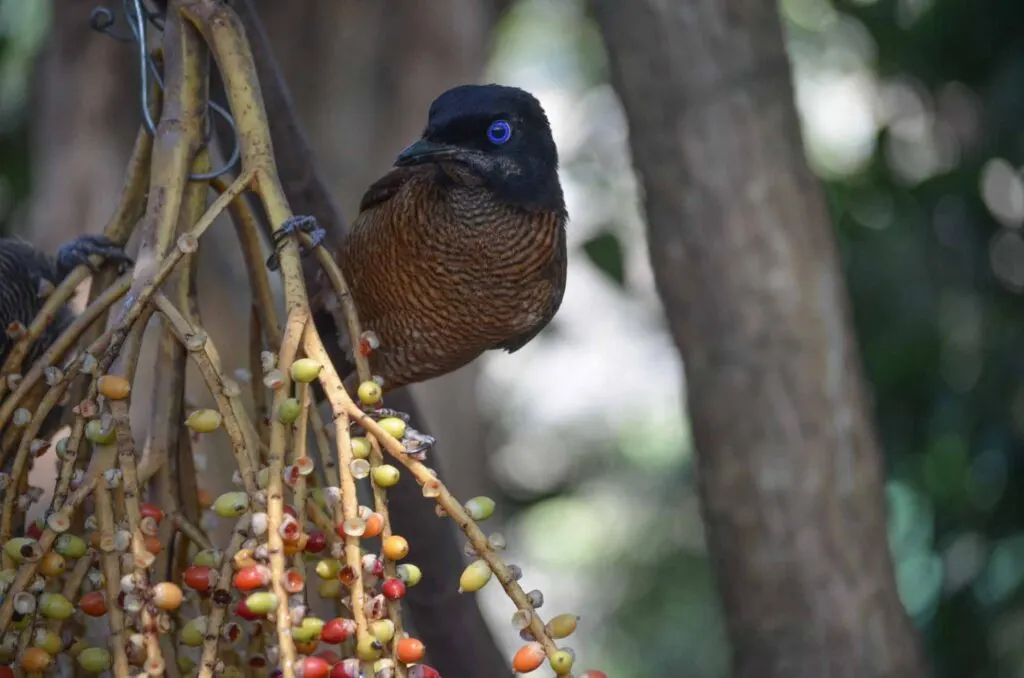
Carola’s parotia is similar in appearance to Lawes’s parotia but with a few notable differences.
Females are distinctly different as they don’t have black heads – they are grey-brown across the entire topside. Males have white flanks and shimmery bronze chests.
Carola’s parotia, Parotia carolae, is known by various names, including Queen Carola’s six-wired bird-of-paradise and Queen Carola’s parotia.
They were named after Queen Carola of Vasa, the wife of King Albert of Saxony, who also has a bird-of-paradise named after him.
Male birds of this type are notable as their courtship display, known as a lek in the bird world, is among the most complex of any bird sort.
These medium-sized birds give it their all and are able to pull up their feathers into a perfect tutu formation while hopping, crouching, and showing off their shiny breasts.
Carola’s parotia live in pockets in the mid-mountain forests of New Guinea. Even though their range is relatively remote, they are plentiful and not under threat.
7. King of Saxony Bird-of-Paradise
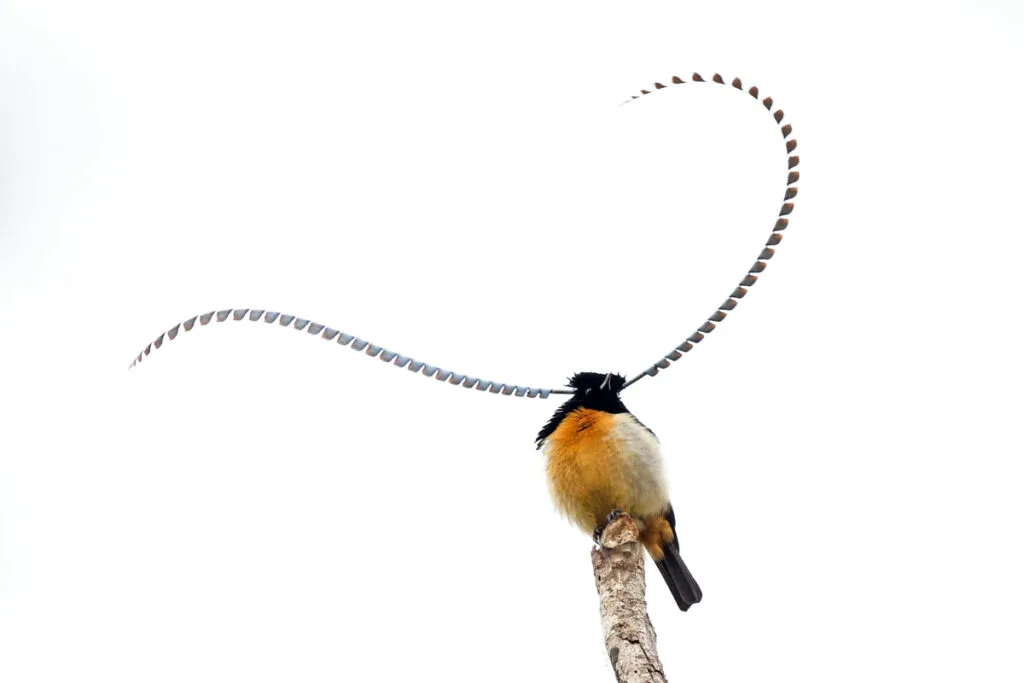
The King of Saxony bird-of-paradise is so unusual that samples were thought to be fake when it was first collected and taken to Europe.
Males have two lengthy brow plumes that need to be seen to be believed. These enamel blue plumes can be almost 20 inches long, and they can wave them around independently.
The male and female King of Saxony bird-of-paradise are visually entirely different. Besides the outlandishly long plume feathers on males, the birds have dark upper bodies with yellow underparts.
Females have grey-brown upper bodies with a textured-looking scalloped pattern on their undersides. Adult males are 8.6 inches long (excluding their two plumes), and females are around 7.8 inches.
The King of Saxony bird-of-paradise is so unique that it is alone in its group. The scientific name for these spectacular show-offs of nature is Pteridophora alberti.
Although males of the species have been hunted for their plumes, their numbers remain steady in their habitat, which is the montane forests of western and central New Guinea.
Did you know? During previous centuries, plumes from bird-of-paradise were sought after in Europe as fashionable adornment for ladies hats.
8. Twelve-Wired Bird-of-Paradise
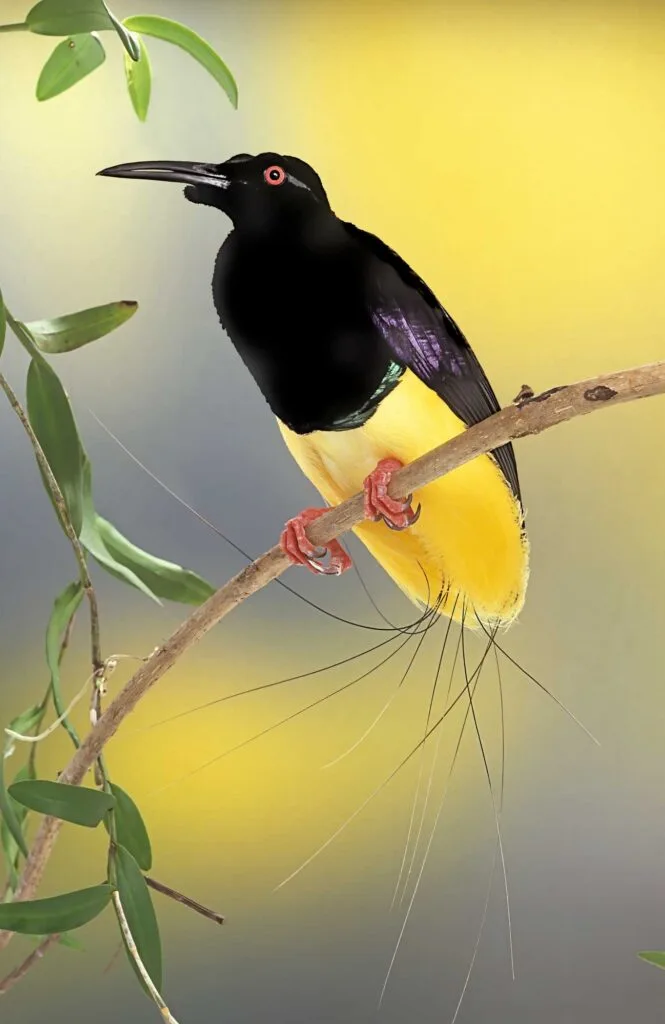
The twelve-wired bird-of-paradise is one of the largest species of this family.
The scientific name for this sexually dimorphic species is Seleucidis melanoleuca. Males can be 13 inches long, and females are often slightly longer.
As if the striking yellow and black plumage of the male birds wasn’t enough to grab the attention of a female, mature males have twelve long, wire-like feather protrusions emerging from their rump.
They use these during their displays to impress their potential mates by brushing them over the front of their bodies.
Female twelve-wired birds-of-paradise are a uniform brown color on top with a barred pattern on the underside. They do not have any of the protruding wire-like feathers that give this species its name.
Unlike many other types of birds-of-paradise, the twelve-wired bird-of-paradise is polygynous, which means that each male may mate with multiple females. Males also take no part in nest building or raising the young.
An unusual feature of twelve-wired birds-of-paradise is that in addition to fruit and insects, they will also feed on nectar.
These birds are not threatened, and a fair amount of their habitat in flat lowland swamp areas of New Guinea and Salawati Island is inaccessible.
Read next: 28 Charming Types of Parrots That Are A Sight to Behold
9. Pale-Billed Sicklebill
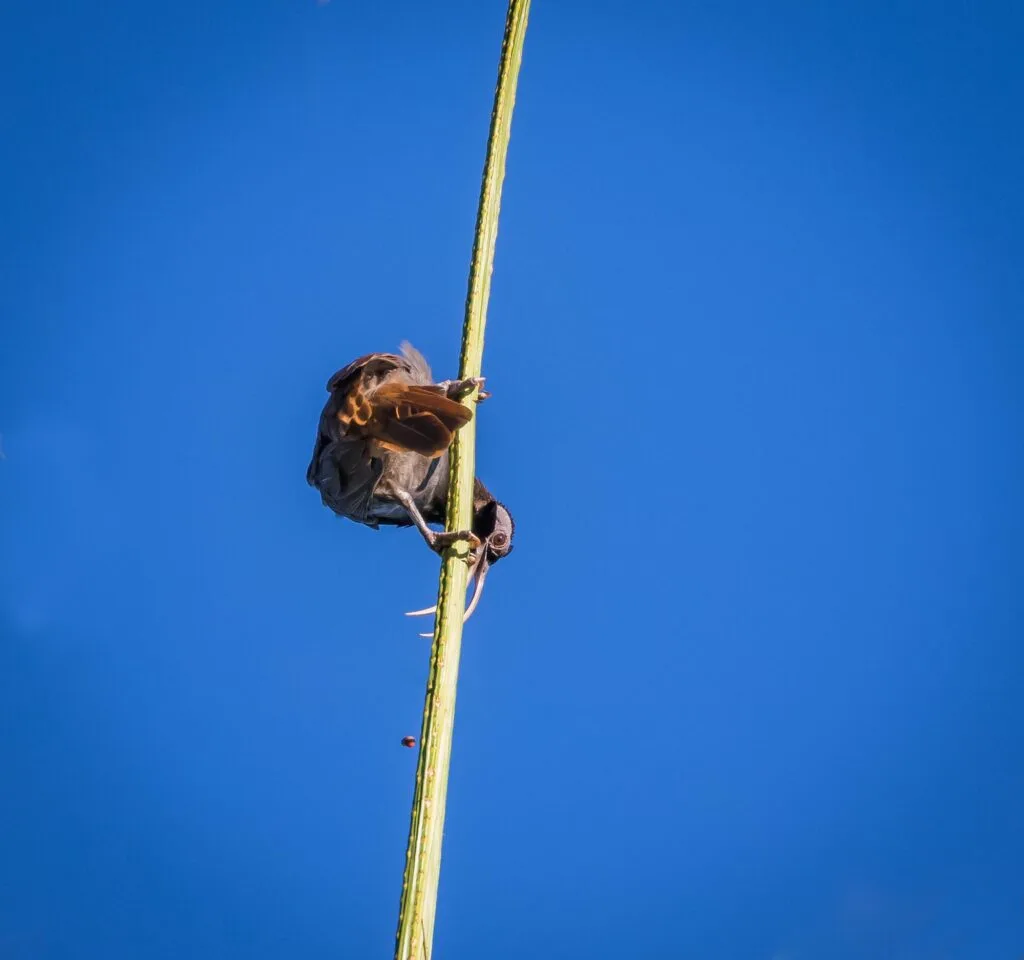
Pale-billed sicklebills are one of the least well-known types of birds-of-paradise. These rather plain members of this good-looking family and sexually dimorphic and have distinctive pale, curved bills.
Malespale-billed sicklebills are slightly larger than females and have an average mature length of around 13.77 inches.
Although there is minimal variation in color between the sexes, females tend to have slightly lighter brownish-olive feathers.
A significant visual difference between the sexes is the notable bare patch of skin below the eyes of males. Although females do also have the facial patch, it is less extensive.
The scientific name Drepanornis bruijnii bares reference to this bird’s sickle beak as well as commemorating a Dutch plume merchant, Antonie Bruijn.
Pale-billed sicklebills inhabit lowland regions in northern and northwestern New Guinea.
According to the Australian Museum, the species is considered near threatened due to habitat loss within its restricted range. Pale-billed sicklebills have a musical-sounding call that includes a few high notes.
10. Wallace’s Standardwing
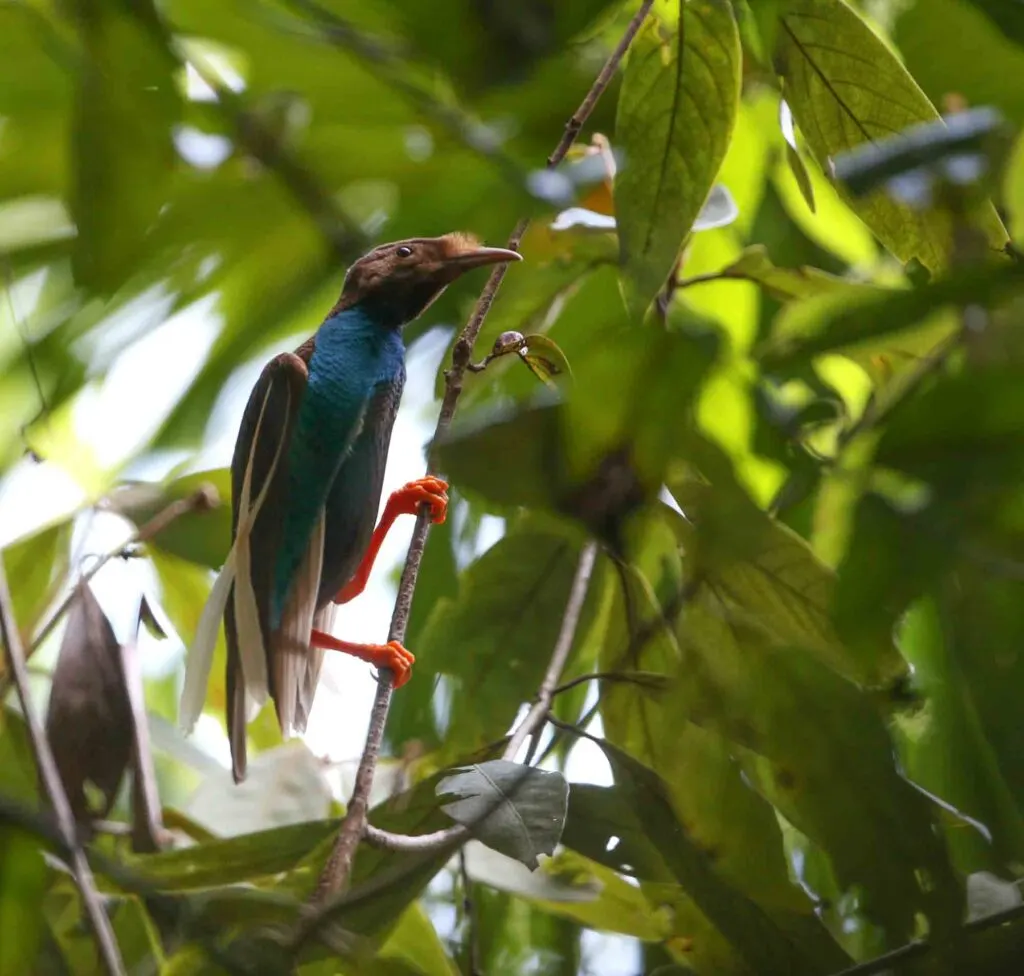
The lowland tropical forest regions of Eastern Indonesia are home to a unique and almost magical-looking bird-of-paradise.
Male Wallace’s standardwing birds-of-paradise are highly ornamental, while females are plain brown.
Female standardwing birds-of-paradise are uniform olive-brown with a pale, curved bill.
Although they are slightly smaller than males, they have longer tails. They do not have any shoulder plumes or any distinctive features.
Male Wallace’s standardwing bird-of-paradise is on the opposite extreme in appearance.
Although they are a medium-sized species and are around 11 inches long, males have a glossy blue-green breast shield and a pair of long white plumes erupting from the bend in each wing.
The scientific name for this species is Semioptera wallacii – the only member in its genus. Wallace’s standardwing was named to honor a British naturalist, Alfred Russel Wallace, who first described the bird in 1858.
11. Greater Lophorina
Although the name may imply the opposite, the greater lophorina is a small bird-of-paradise type with an average length of just 10 inches.
The species is sexually dimorphic, and since there is an unusually low ratio of females to males, competition amongst males is intense.
Greater lophorinas are also often called superb bird-of-paradise or greater bird-of-paradise.
It was alone in its genus for almost 200 years before two similar yet quite distinct species were described in 2017.
Female greater lophorina birds-of-paradise have a plain brown topside with a soft barred pattern on the underside.
In contrast, males are jet black with shimmery green crowns. What makes greater lophorina males stand out is the metallic green-blue breast shield and erectile fans that it lifts over its head during courtship displays.
This remarkable species mainly inhabits rainforests in New Guinea and Indonesia. It can also be found in mountainous areas, although they seem to prefer forest edges.
The feeding habits of the greater lophorina are slightly different from many other types of birds-of-paradise.
In addition to the expected fruit and insect diet typical of most extended family members, they have also been observed hunting for small reptiles and birds. They are also known to forage on the forest floor for insects.
12. Victoria’s Riflebird
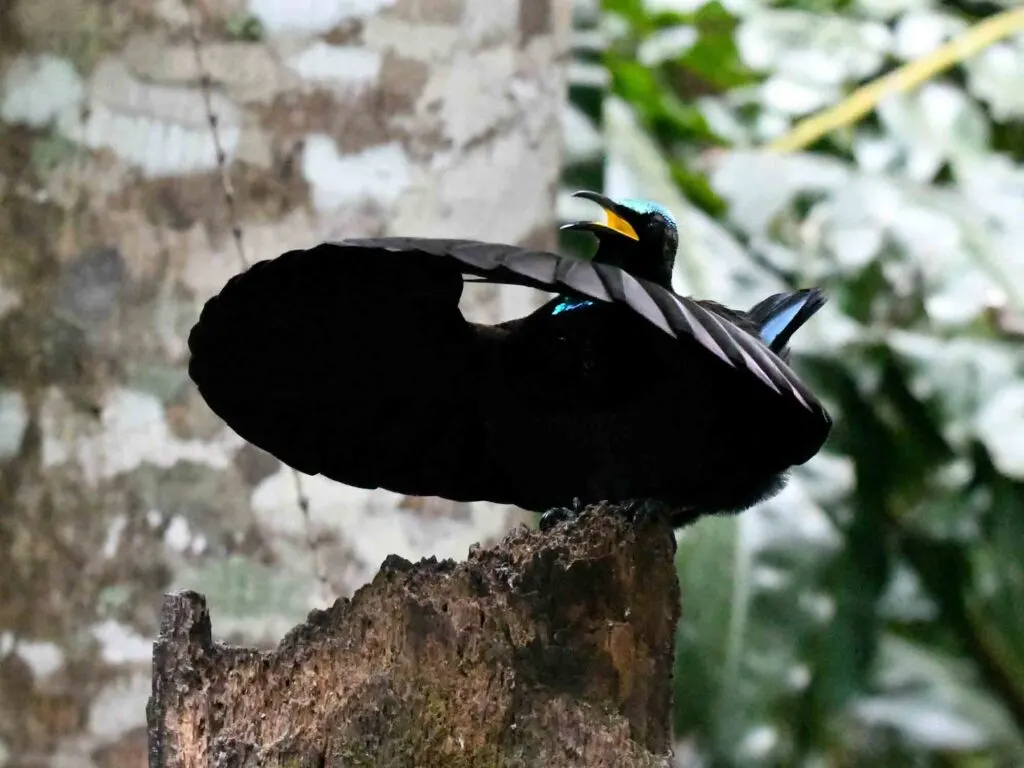
Named after Queen Victoria, Victoria’s Riflebird is a species of bird-of-paradise found in northeastern sections of Queensland in Australia.
These sexually dimorphic birds live in lowland areas, swampy woodlands, and mangroves and can even occasionally be spotted in residential gardens.
The scientific name for Victoria’s riflebird is Ptiloris victoriae. In addition to the reference to the queen at the time of its naming, it includes the word ptiloris.
This is Greek and refers to the bird’s feathered ‘nose’ or, rather, the feathers at the base of its beak.
Although male and female birds of the species are entirely different in appearance, they are similar in size.
Mature adults of both sexes are around 9 inches long. They are the smallest species of riflebirds.
Male Victoria’s riflebirds have beautiful black feathers that show off an iridescent purple sheen.
The real showstopper is their throat which has a triangular patch of metallic green color in the center.
Males are able to curve their wings around their bodies to form a circle shape while simultaneously puffing out their shiny throat feathers.
Female Victoria’s riflebirds are a medium brown on their topsides, with pretty textured cinnamon and dark-colored pattern on the underparts. They have a distinctive pale line above their eyes which fades into their body color.
These beautiful little birds were named riflebirds as a reference to their dark, velvety plumage, reminiscent of British riflemen’s uniforms at the time.
Victoria’s riflebirds are listed as vulnerable on the IUCN Red List.
13. Magnificent Riflebird
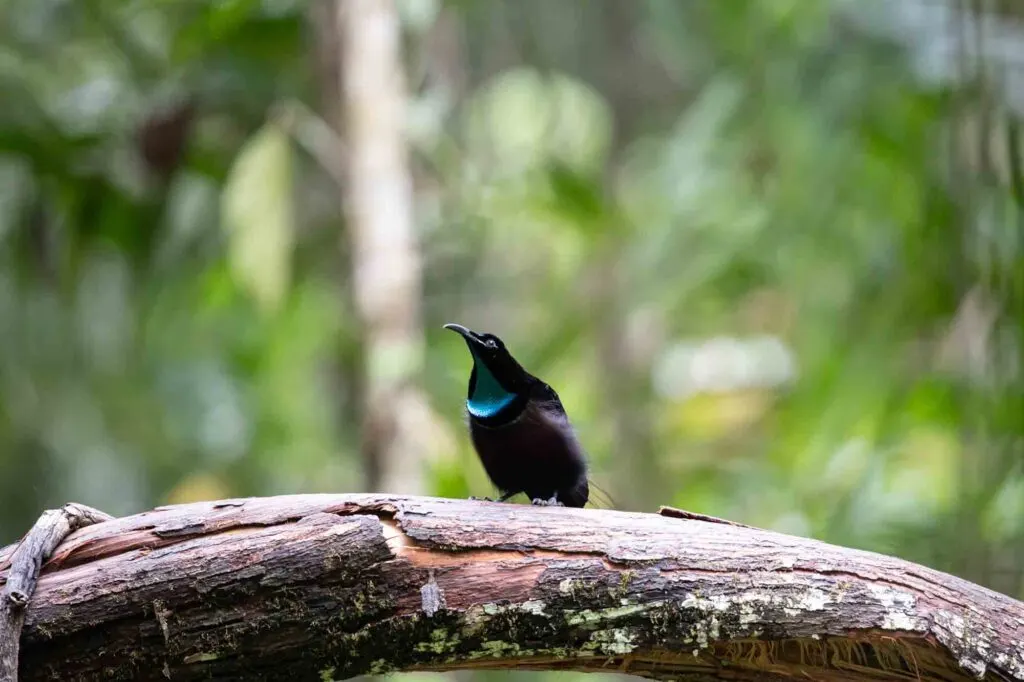
Unlike Victoria’s riflebird, magnificent riflebirds are widely distributed throughout their range and are evaluated as a species of Least Concern on the IUCN Red List. They are found in the lowland forests of northern Australia and New Guinea.
What makes this medium-sized bird-of-paradise unique is the male bird’s broad, iridescent, triangle-shaped breast shield.
Like many other males in the family, magnificent riflebirds have developed an elaborate courtship display to attract female mates, but what makes this species different is that they designate a special ‘dancing perch.’
In effect, they have their own little stage to perform their routine.
Female magnificent riflebirds are an average length of 11 inches which is 3 inches shorter than males.
They have similar patterning to female Victoria riflebirds, but of course, they are significantly larger.
The scientific name for this species is Ptiloris magnificus which is a combination of the words meaning feathered nose and magnificent.
Like most types of birds-of-paradise, their diet consists mainly of tropical fruit and insects, although they will also prey on small animals.
14. Brown Sicklebill
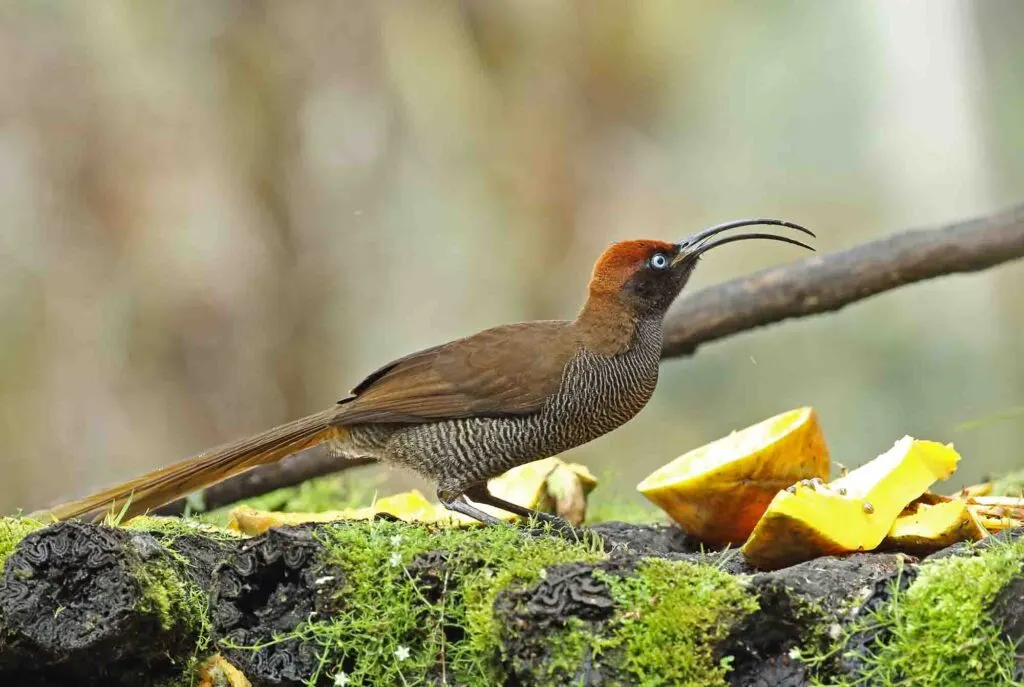
Deep in the lush mountain forests of New Guinea, you will find one of the longest types of birds-of-paradise.
Adult brown sicklebills measure an astonishing 1.2 feet, and although they are large, that measurement also includes their long ornamental plumes and tail feathers.
Brown sicklebills are also known as Meyer’s sicklebill after one of the authors who formally described this species in 1886.
In fact, the scientific name for the brown sicklebill is Epimachus meyer which still bears testament to those first explorers.
Male brown sicklebills have sought after plumage, making them a target for feather collectors.
These birds-of-paradise have pale underbellies, pale blue eyes, and long curved beaks.
In addition to the impressively long tail plumes, the rest of his ornamental plumage is highly iridescent shades of blue and bottle green.
By contrast, although female brown sicklebills have similarly long tail feathers, they do not have any showy plumes or shimmering colors.
They are a rusty brown color on top with speckled bar patterning on the underside.
An interesting note about the brown sicklebill bird-of-paradise is its peculiar call which can sound like a volley of gunfire.
In addition to fruit and insects, this large bird species will prey on small animals. The species is not on the threatened list.
15. Short-Tailed Paradigalla
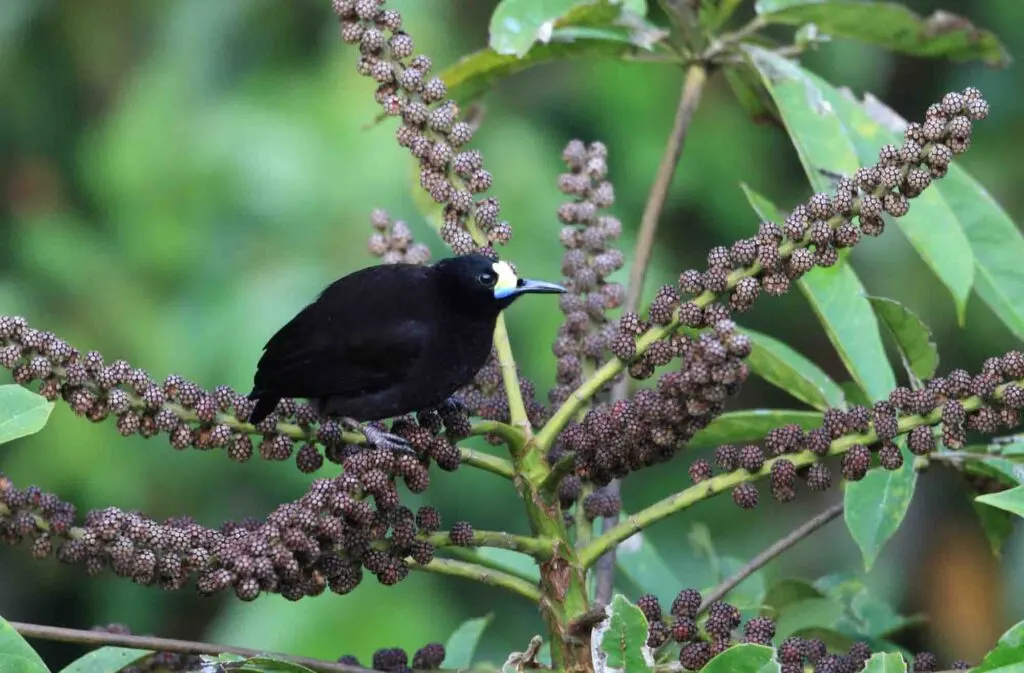
Short-tailed Paradigalla birds are stocky black birds with notably short tails.
This feature, or lack thereof, led to their scientific name, Paraigalla brevicauda, which alludes to this their stumpy-looking backend.
There is very little difference between the sexes. Both are around 9 inches long and sport black feathers and a long black bill.
The most characteristic feature of the species is the bright yellow wattle on the forehead, with a contrasting blue wattle below each eye.
This species of bird-of-paradise is not threatened, and although they occur in patchy areas over a large region, they are plentiful.
Their diet includes fruit, insects, small animals, worms, and skinks.
Short-tailed paradigalla birds-of-paradise inhabit montane forests and may even visit garden edges in the western and central mountain ranges of New Guinea.
Males are polygynous; females do everything related to rearing young, including building the nest. They have been known to reuse their cup-shaped nests in tree forks.
16. Ribbon-Tailed Astrapia
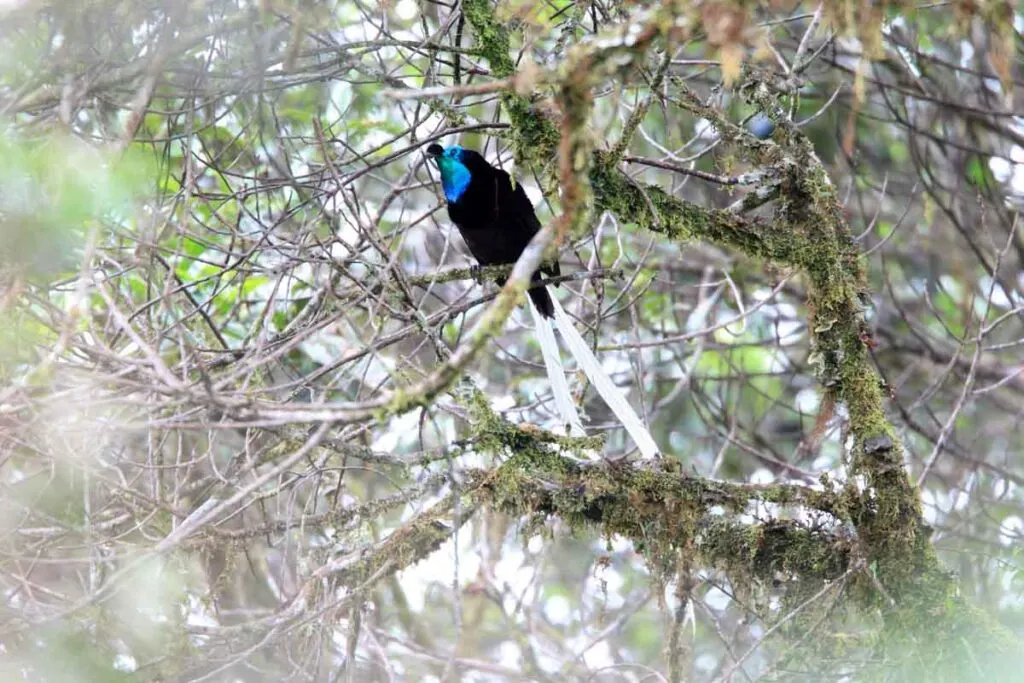
One of the most recently described types of birds-of-paradise is the ribbon-tailed astrapia. This eye-catching species, Astrapia mayeri, managed to evade detection for a long time.
It inhabits subalpine forests in the highlands of Papua New Guinea, which are remote, uninhabited, and inaccessible.
As the name suggests, the male ribbon-tailed astrapia has two impressively long white tail feathers that stand out from the rest of its plumage.
In fact, the bird’s length, without considering the tail extensions, is only around 12.5 inches. Add on the tail, and their length is closer to 1.6 feet!
Males and females of the species are sexually dimorphic. Males flit around, showing off their metallic green to dark purple color upper bodies and their inky black heads.
They also have a little puffy ornamental ball on their bill, which resembles a small pompom.
Female ribbon-tail astrapia birds-of-paradise have similar but less striking coloring along the upper section of their bodies.
They are 13.7 inches long, and their brown tail feathers show a hint of white along their length.
Ribbon-tailed astrapia eat fruit and insects like most other types of birds-of-paradise. Their favorite is the fruit from the Umbrella tree. In addition, they will consume spiders and frogs.
17. Magnificent Bird-of-Paradise

There is plenty of variation in the tail feathers between different types of birds-of-paradise.
One of the most unique styles is found on the male magnificent bird-of-paradise. Males have two long light blue sickle-shaped tail feathers that curl upwards at each side to form two big loops.
The scientific name for this species also refers to the long tail feathers. It is Diphyllodes magnificus which means double leaf (shaped) magnificent.
These colorful, medium-sized birds inhabit low montane forests in mainland New Guinea, Indonesia, and some surrounding islands.
The length of an adult magnificent bird-of-paradise is around 7.4 inches, but that is without taking into account the long tail of male birds, which pushes the figure to more than 10 inches.
Although males are brightly colored and feature a bright yellow cape over their back, female magnificent bird-of-paradise are subtle shades of rusty brown with textured, barred undersides.
They have elaborate mating rituals that include a comical dance. Before mating occurs, rival female birds who have watched the dance, which includes the male raising his yellow mantle around his head and waggling his unique tail from side to side, may intervene to chase off the core female.
This means the male often needs to repeat the performance a few times before he can successfully mate.
18. Blue Bird-of-Paradise
The blue bird-of-paradise (Paradisornis rudolphi) is one of the most attractive of the family.
While some of the other relations may seem like a random assortment of colors, all splashed together; blue birds-of-paradise are the fashionistas of the group.
Although they are dimorphic, the males and females of the species complement each other perfectly.
Both have shimmery blue wings, which stand out in sharp contrast to their jet-black bodies.
Males have a mass of blue-tinged flank feathers that emerge from a band of bright red and back at the top of the inner plumes.
The blue bird-of-paradise is a large species, and mature individuals are around 11.8 inches long.
In addition to the fluffy-looking plumes, males have two long black tail wires with white tips.
Females do not have tail wires, and their underbellies are browner, but both sexes have grey legs, white eye crescents around their eyes, and light color bills.
As you may have realized by now, male birds-of-paradise don’t hold back when it comes to elaborate courtship displays, and blue bird-of-paradise is no exception.
These beautiful birds take things to the next level and perform their displays hanging upside down from a thin branch.
The diet of these birds consists mainly of fruit, and like many other types of birds-of-paradise, they have been known to also prey on small animals.
Unfortunately, blue bird-of-paradise numbers are in decline due to habitat loss and poaching for their beautiful feathers.
List of All Bird-of-Paradise Species
Here’s a list of all species of bird-of-paradise by genus.
Lycocorax
Halmahera paradise-crow, Lycocorax pyrrhopterus
Obi paradise-crow, Lycocorax obiensis
Manucodia
Glossy-mantled manucode, Manucodia ater
Tagula manucode, Manucodia alter
Jobi manucode, Manucodia jobiensis
Crinkle-collared manucode, Manucodia chalybatus
Curl-crested manucode, Manucodia comrii
Phonygammus
Trumpet manucode, Phonygammus keraudrenii
Paradigalla
Long-tailed paradigalla, Paradigalla carunculata
Short-tailed paradigalla, Paradigalla brevicauda
Astrapia
Arfak astrapia, Astrapia nigra
Splendid astrapia, Astrapia splendidissima
Ribbon-tailed astrapia, Astrapia mayeri
Stephanie’s astrapia, Astrapia stephaniae
Huon astrapia, Astrapia rothschildi
Parotia
Western parotia, Parotia sefilata
Carola’s parotia, Parotia carolae
Bronze parotia, Parotia berlepschi
Lawes’s parotia, Parotia lawesii
Eastern parotia, Parotia helenae
Wahnes’s parotia, Parotia wahnesi
Pteridophora
King of Saxony bird-of-paradise, Pteridophora alberti
Lophorina
Greater lophorina, Lophorina superba
Crescent-caped lophorina, Lophorina niedda
Lesser lophorina, Lophorina minor
Ptiloris
Magnificent riflebird, Ptiloris magnificus
Growling riflebird, Ptiloris intercedens
Paradise riflebird, Ptiloris paradiseus
Victoria’s riflebird, Ptiloris victoriae
Epimachus
Black sicklebill, Epimachus fastosus
Brown sicklebill, Epimachus meyeri
Drepanornis
Black-billed sicklebill, Drepanornis albertisi
Pale-billed sicklebill, Drepanornis bruijnii
Cicinnurus
King bird-of-paradise, Cicinnurus regius
Magnificent bird-of-paradise, Cicinurrus magnificus/Diphyllodes magnificus
Wilson’s bird-of-paradise, Cicinnurus respublica/Diphyllodes respublica
Diphyllodes
Magnificent bird-of-paradise, Diphyllodes magnificus
Wilson’s bird-of-paradise, Diphyllodes respublica
Semioptera
Standardwing bird-of-paradise, Semioptera wallacii
Seleucidis
Twelve-wired bird-of-paradise, Seleucidis melanoleucus
Paradisaea
Lesser bird-of-paradise, Paradisaea minor
Greater bird-of-paradise, Paradisaea apoda
Raggiana bird-of-paradise, Paradisaea raggiana
Goldie’s bird-of-paradise, Paradisaea decora
Red bird-of-paradise, Paradisaea rubra
Emperor bird-of-paradise, Paradisaea guilielmi
Paradisornis
Blue bird-of-paradise, Paradisornis rudolphi
That’s it for birds-of-paradise types! Enjoyed the article? Be sure to share it on your social media channels!
18 Beautiful Types of Birds-of-Paradise
1. King Bird-of-Paradise
2. Raggiana Bird-of-Paradise
3. Trumpet Manucode
4. Crinkle-Collared Manucode
5. Lawes’s Parotia
6. Carola’s Parotia
7. King of Saxony Bird-of-Paradise
8. Twelve-Wired Bird-of-Paradise
9. Pale-Billed Sicklebill
10. Wallace’s Standardwing
11. Greater Lophorina
12. Victoria’s Riflebird
13. Magnificent Riflebird
14. Brown Sicklebill
15. Short-Tailed Paradigalla
16. Ribbon-Tailed Astrapia
17. Magnificent Bird-of-Paradise
18. Blue Bird-of-Paradise
